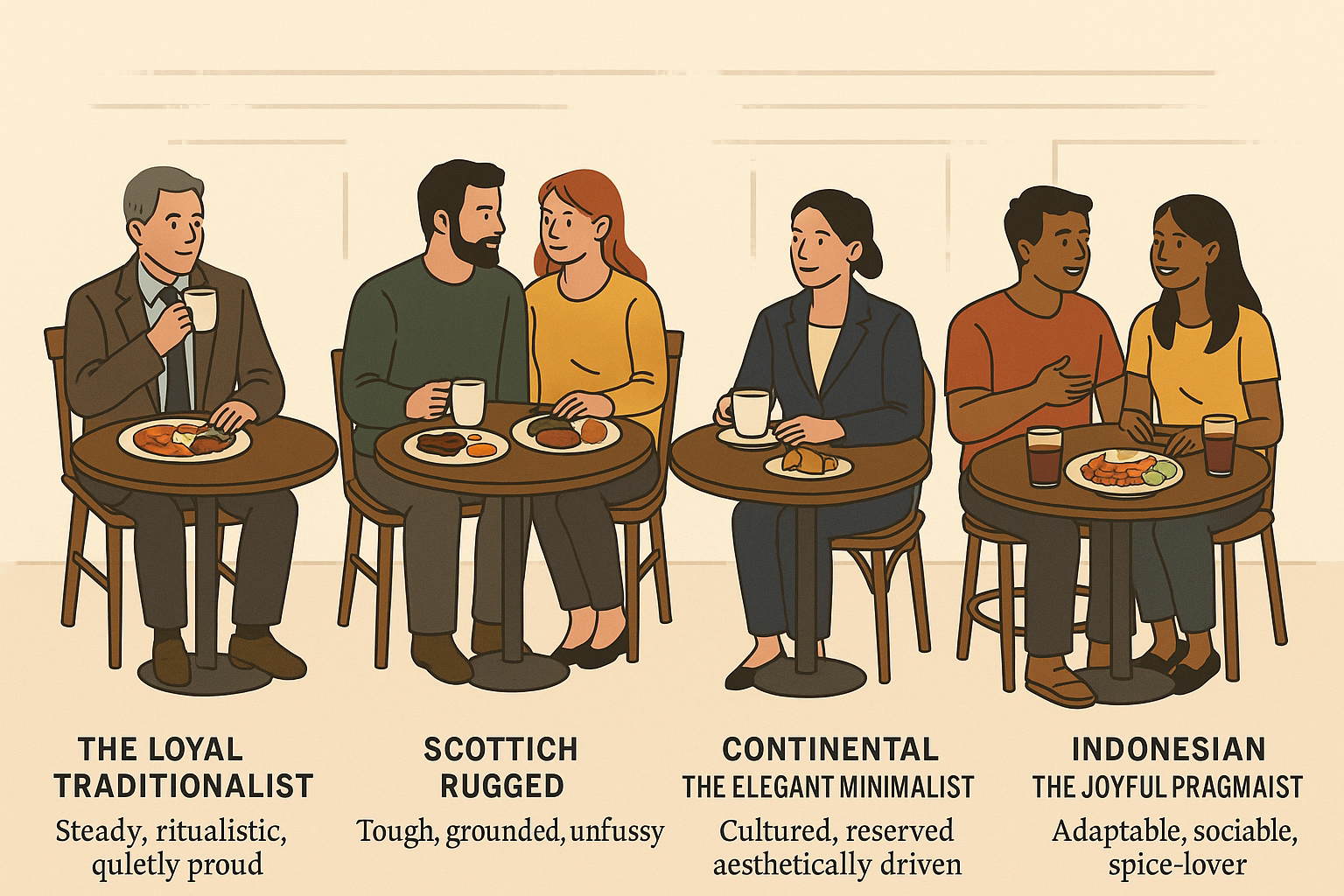BREAKFAST IDENTITIES
1. Introduction: Breakfast as Cultural Expression
Breakfast is more than a functional start to the day; it is a social and cultural event. The way societies structure, value, and consume breakfast reflects broader ideas of time discipline, social structure, national identity, and globalisation. This paper examines four culturally significant breakfast traditions - English, Scottish, Continental, and Indonesian - to explore how the morning meal functions as a ritualised practice revealing values, identities, and lived rhythms.
2. The English Breakfast: Institutional Ritual
The full English breakfast is a legacy of Britain’s industrial and imperial history. Comprising sausages, bacon, eggs, mushrooms, tomatoes, baked beans, toast, and occasionally black pudding, it is calorically dense and symbolically loaded. This meal functions as a ritualistic performance of British identity, evoking notions of respectability, consistency, and social order.
It is often consumed in cafés, hotels, bed-and-breakfast establishments, "greasy spoon" and remains one of the most enduring food practices in modern Britain. In a rapidly transforming society, the full English breakfast endures as a nostalgic assertion of national continuity and personal discipline.
3. The Scottish Breakfast: Landscape and Identity
Scotland's breakfast builds on the English tradition but introduces elements unique to its geography and cultural heritage. The presence of Lorne sausage, tattie scones, black pudding, and haggis ties the meal to the rugged Highlands, where sustenance is linked with survival.
Here, breakfast communicates resilience and authenticity. The ruggedness of the Scottish landscape is encoded in the calorific content and earthy flavours of the meal. It is a culinary reflection of stoicism and a quietly poetic connection to land and labour.
4. The Continental Breakfast: Minimalism and Mobility
By contrast, the Continental breakfast - common in France, Italy, and Spain - is light, rapid, and elegant. It typically includes bread or pastry, butter, jam, and coffee or tea. In hotel and café contexts, this breakfast is a gesture rather than a meal, a social placeholder rather than a nutritional event.
The Continental breakfast reflects a cultural priority on aesthetics, leisure, and rhythm over substance. It implies a mobile, urban life where breakfast is a prelude to productivity rather than a pause in it.
5. The Indonesian Breakfast: Informality and Abundance
In Indonesia, breakfast is practical, warm, and often indistinct from other meals. Dishes such as nasi goreng (fried rice), bubur ayam (chicken porridge), or lontong sayur (rice cakes in coconut curry) are not confined to a breakfast category. Food is often consumed in communal outdoor settings, prepared by street vendors, and flavoured with mild spice.
This breakfast practice prioritises adaptability and shared space over ceremony. It reveals a social orientation toward community, informality, and pragmatism — a form of nourishment that bridges time and place.
6. Glossary and Etymological Notes
Breakfast: From Old English "brecan" (to break) + "fæstan" (to fast), referring to the breaking of the overnight fast.
Tattie scone: A potato-based griddle cake from Scotland.
Lorne sausage: A square sausage made from minced meat and spices, typical in Scottish breakfasts.
Nasi goreng: Indonesian fried rice, often flavoured with sweet soy sauce and topped with egg.
Lontong sayur: Rice cakes served with a spiced coconut vegetable stew.
Continental: Used in contrast with British customs, typically referring to light European breakfasts of French or Italian origin.
Breakfast is deeply embedded in religious and cultural schedules. While European models tend toward formalisation, equatorial and tropical regions maintain flexible, often savoury and portable practices. Fasting traditions, such as Ramadan, Lent, or Buddhist morning abstinence, further shape the experience.
7. Recipes
English Breakfast: Fry sausages, bacon, and eggs. Grill tomatoes and mushrooms. Heat baked beans. Serve with toast and tea.
Scottish Breakfast: Fry Lorne sausage and black pudding. Prepare tattie scones with mashed potato, flour, and butter. Add poached egg and toast.
Continental Breakfast: Warm croissants or bread. Serve with butter, jam, and coffee. Juice optional.
Indonesian Breakfast: Stir-fry cooked rice with garlic, chilli, sweet soy sauce, and egg. Garnish with fried shallots and cucumber. Serve with sweet tea.
8. Typologies of the Breakfast Eater
English: The Loyal Traditionalist — values ritual, order, and cultural heritage.
Scottish: The Rugged Stoic — grounded, self-reliant, closely tied to land and tradition.
Continental: The Elegant Minimalist — prioritises form, discretion, and cultural rhythm.
Indonesian: The Joyful Pragmatist — flexible, sociable, and integrated into communal life.
9. Conclusion: Breakfast as Self-Disclosure
Breakfast reveals more than nutritional preference. It encapsulates rhythms of identity, mobility, and meaning. Whether minimalist or abundant, ceremonial or improvised, breakfast symbolises how we orient ourselves in the world. It asks - and answers - the question: who are you when you wake?








0 comments:
Post a Comment
Keep it clean, keep it lean